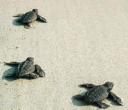Turtle Conservation: Karimunjawa, Central Java
 The turtle population in Karimunjawa archipelago, north of Central Java, has been decreasing due to local people’s consumption of turtle meat and eggs, while the sea reptile’s habitat has also been damaged, posing the threat of extinction. Turtles have been hunted, slaughtered and consumed by locals. To conserve the protected species, wildlife observers affiliated with the center launched a conservation drive in July 2004, setting up a semi-natural turtle hatching center on Karimunjawa’s Menjangan Besar Island. This 56-hectare island was chosen because of its conformity to turtle hatching requirements and its proximity to the main island, Karimunjawa Island, which is only 10 minutes’ sail away, thus facilitating control.
The turtle population in Karimunjawa archipelago, north of Central Java, has been decreasing due to local people’s consumption of turtle meat and eggs, while the sea reptile’s habitat has also been damaged, posing the threat of extinction. Turtles have been hunted, slaughtered and consumed by locals. To conserve the protected species, wildlife observers affiliated with the center launched a conservation drive in July 2004, setting up a semi-natural turtle hatching center on Karimunjawa’s Menjangan Besar Island. This 56-hectare island was chosen because of its conformity to turtle hatching requirements and its proximity to the main island, Karimunjawa Island, which is only 10 minutes’ sail away, thus facilitating control.
A survey had found that there were economic motives behind the turtle demand, with hunters seeking extra income and buyers wanting cheaper meat for festivities as Slamet Susanto explains further. The archipelago has 27 islands and only five are inhabited. Nearly all of the islands are home to sea turtles. For the protection of Karinmunjawa’s green and hawksbill turtles, fishermen discovering turtle nests and reporting them to the conservation park are given fuel compensation, which depends on the distance of the burrows from the hatching center and comes within the range of Rp 250,000-600,000. The compensation is higher than their income from turtle egg sales so that generally locals choose to report to the park.
The center’s field officers collect eggs from the nests to prevent them from being damaged. They are hatched on the shore of Menjangan Besar Island, where a semi-natural hatchery measuring two by four meters is ready to contain about 12 buckets of turtle eggs. The use of buckets is meant to protect the eggs against predators and make control easier. After hatching, baby turtles are put into baskets until the “appropriate” time for their release into the wild, usually in a tourism promotion event. The center receives donations for conservation purposes from visitors during such events. “All expenses are covered by the national park but sometimes we get extra funds from turtle release donors for hatchery safeguarding costs,” he said.
 Young turtles should ideally be released in the place where their eggs were found in the hope that as adults later, they will return there to lay eggs. But not all the young can be freed in their original nest because of the high cost of doing this. The center has also been campaigning for turtle conservation by appealing that all turtles netted while fishing be released into the sea. According to Sutris, most of the 9,000 people in the island group are fishermen, so that turtles are frequently caught in the fishing nets they set up.
Young turtles should ideally be released in the place where their eggs were found in the hope that as adults later, they will return there to lay eggs. But not all the young can be freed in their original nest because of the high cost of doing this. The center has also been campaigning for turtle conservation by appealing that all turtles netted while fishing be released into the sea. According to Sutris, most of the 9,000 people in the island group are fishermen, so that turtles are frequently caught in the fishing nets they set up.
Out of the 8,183 eggs gathered, 4,310 or 53 percent had hatched so far. Nearly all of the eggs put in the hatchery have come from nests reported by local fishermen. Tagging has also been conducted to monitor the turtles landing on the islands, involving 34 green turtles and 94 hawksbill turtles.
In general, turtle conservation applies two methods. The first is the conservative or natural method, by allowing turtles to hatch naturally in their nests and preventing egg thefts. “Turtles’ landing habitat is also monitored in this conservative system of conservation.
The second is the positive conservation method of increasing the turtle population. Their eggs are moved to the hatchery and their young nursed for some time before being released to nature. Susi added that in a 2002 survey, the total number of turtles in the Karimunjawa islands was estimated at only 200. The study was based on the nests they left behind and landing areas.
Conservation officials at the park expressed hope the widely supported conservation effort would protect and restore the turtle population. Restoring turtle numbers in the area would also benefit local fishermen because these animals consume red algae, which may be lethal to fish spawn.